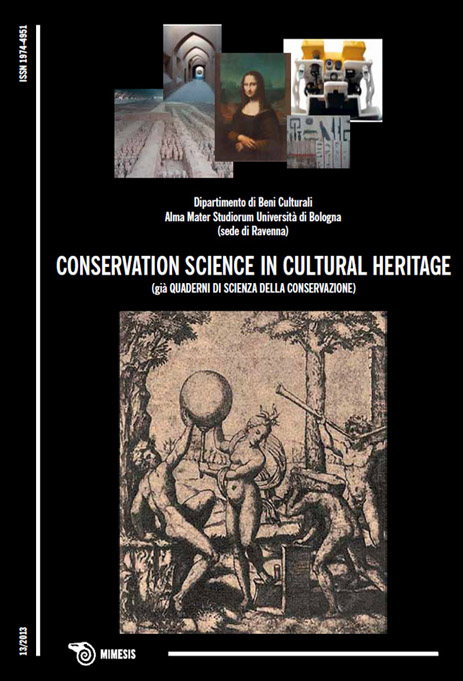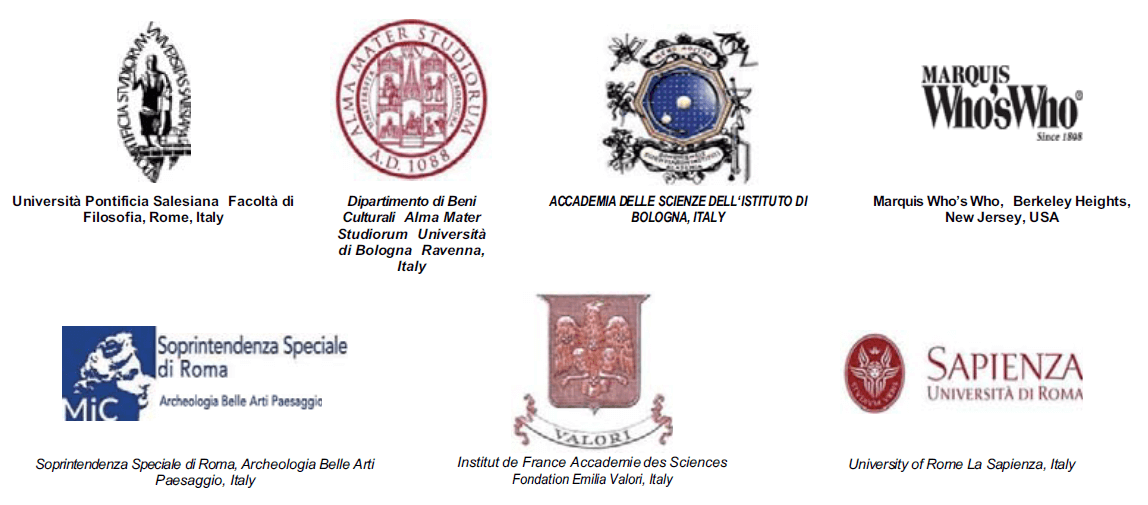Study of mosaic glasses from the Alpha Basilica (sixth century) of Nikopolis in Epirus, Greece
DOI:
https://doi.org/10.6092/issn.1973-9494/4186Keywords:
Nikopolis in Epirus, ancient glass, mosaic glass, Byzantine basilica, RavennaAbstract
SummaryAfter collecting the essential historical, archaeological, and artistic information relative to the ancient town of Nikopolis in Epirus and its Alpha (or Doumetios) Basilica, built in the sixth century A.D., glass tesserae belonging to degraded and lost parts of the mosaic floors of the basilica were analysed, determining their chemical composition and the possible presence of crystalline phases. As in all glasses produced in the Mediterranean area in that epoch, they are soda-lime silicate glasses, in part with lead, obtained using natron as a flux. The typology of the glass corresponds to that of Roman glasses, of the first centuries A.D., and is the same as that employed for the basilicas of Ravenna in the fifth and sixth centuries; in particular, a comparison was made with the glass tesserae of the St Vitale Basilica. The technological base for producing coloured glasses is also practically the same as that of the mosaic glasses of Ravenna. In particular, antimony was used as an opacifying element and a fusion was carried out under reducing conditions to obtain red glass with microparticles of metallic copper. Thus, it can be supposed there was a common source of production of the mosaic glasses used in Nikopolis and Ravenna in the sixth century and that this source was in the Near Orient.
Riassunto
Dopo la raccolta delle informazioni essenziali di carattere storico, archeologico e artistico relative all’antica città di Nicopoli d’Epiro e alla sua Basilica Alfa (o Doumetios), costruita nel VI secolo d.C., sono state analizzate tessere vitree che appartenevano a parti dei pavimenti musivi della basilica degradate e andate perdute, determinando la loro composizione chimica e la eventuale presenza di fasi cristalline. Come tutti i vetri dell’epoca prodotti in area mediterranea si tratta di vetri silicatico-sodico-calcici, in parte piombici, ottenuti usando natron quale fondente. La tipologia del vetro corrisponde a quella dei vetri Romani, dei primi secoli d.C., ed è la stessa dei vetri musivi impiegati nelle basiliche ravennati del V e VI secolo; in particolare il confronto è stato effettuato con la composizione delle tessere vetrose della basilica di San Vitale. Anche la tecnologia alla base dell’ottenimento dei vetri colorati è praticamente la stessa dei vetri ravennati. In particolare, è stato usato antimonio come elemento opacizzante e condotta una fusione in ambiente riducente per ottenere vetro rosso con microparticelle di rame metallico. Si può, dunque, fare l’ipotesi di una fonte produttiva comune dei vetri musivi impiegati a Nicopoli e a Ravenna nel VI secolo e che tale fonte fosse nel Vicino Oriente.
Résumé
Après la collecte des informations essentielles à caractère historique, archéologique et artistique concernant la ville antique de Nicopolis d’Épire et sa basilique Alpha (ou Doumetios), construite au VIe siècle apr. J.-C., il a été procédé à l’analyse des tesselles de verre qui appartenaient à des parties des pavements de mosaïque de la basilique qui ont été dégradés et perdus, à la définition de leur composition chimique et au relevé d’une éventuelle présence de phases cristallines. Comme tous les verres de l’époque fabriqués dans la région méditerranéenne, il s’agit de verres silico-sodiques-calciques, en partie plombiques, qui ont été obtenus en utilisant le natron comme fondant. La typologie du verre correspond à celle des verres romains des premiers siècles apr. J.-C., et c’est la même que celle des verres de mosaïque employés dans les basiliques de Ravenne des Ve et VIe siècles. Notamment, une comparaison a été effectuée sur la composition des tesselles de verre de la basilique de Saint-Vital. La technique permettant d’obtenir des verres colorés est pratiquement la même que celle des verres de Ravenne. En particulier, l’antimoine a été utilisé comme élément opacifiant, et une fusion en milieu réducteur a permis d’obtenir un verre rouge avec des microparticules de cuivre métallique. Nous pouvons donc émettre l’hypothèse d’une source commune de fabrication des verres de mosaïque utilisés à Nicopolis et à Ravenne au VIe siècle, et que cette source se trouvait au Proche Orient.
Zusammenfassung
Nachdem die wesentlichen historischen, archäologischen und künstlerischen Informationen über die antike Stadt Nikopolis in Epirus und ihre im 6. Jahrhundert n. Chr. errichtete Basilika Alpha (auch Doumetios) eingeholt worden waren, wurden Glassteine analysiert, die zu zerstörten und verloren gegangenen Teilen des Mosaikbodens der Basilika gehörten, um ihre chemische Zusammensetzung und den eventuellen Gehalt an Kristallphasen zu bestimmen. Wie alle anderen Glassorten, die damals im Mittelmeergebiet hergestellt wurden, handelt es sich auch hier um silikat-, natrium- und kalkhaltiges, teils auch bleihaltiges Glas, das unter Verwendung von Natron als Schmelzmittel hergestellt wurde. Diese Glassorte entspricht derjenigen der Römischen Gläser aus den ersten Jahrhunderten n. Chr. und es ist die gleiche Glassorte, wie die der Glassteine, die in den Basiliken von Ravenna aus dem 5. und 6. Jahrhundert verwendet wurden. Im Einzelnen wurde der Vergleich mit den Mosaiksteinen aus Glas in der Basilika San Vitale vorgenommen. Auch die Technik der Herstellung farbigen Glases ist praktisch die gleiche, die in Ravenna zum Einsatz kam. Insbesondere wurde Antimon zur Opakisierung und ein Reduktions-Schmelzverfahren zur Herstellung roten Glases mit Mikropartikeln metallischen Kupfers verwendet. Es kann also angenommen werden, dass die Mosaik-Glassteine in Nikopolis und Ravenna im 6. Jahrhundert aus der gleichen Produktionsquelle stammten, und dass sich diese Quelle im Vorderen Orient befand.
Resumen
Tras haber recogido la información esencial desde el punto de vista histórico, arqueológico y artístico sobre la antigua ciudad de Nicópolis de Epiro y de su Basílica Alfa (o de Dumetios), construida en el siglo VI d.C., se han analizado las teselas de vidrio pertenecientes a partes del pavimento musivario de la basílica, las cuales han sufrido degrado o han desaparecido, para determinar su composición química y la eventual presencia de fases cristalinas. Al igual que los demás vidrios producidos en el área del Mediterráneo en aquella época, se trata de vidrios de silicato sódico cálcico, en parte plúmbicos, obtenidos utilizando natrón como fundente. El tipo de vidrio corresponde al de los vidrios romanos de los primeros siglos d.C. y es el mismo de los vidrios musivarios empleados en las basílicas de Rávena en los siglos V y VI; en particular, se ha realizado una comparación con la composición de las teselas de vidrio de la basílica de San Vital. Incluso la tecnología empleada para obtener vidrios de colores es prácticamente la misma que la de los vidrios de Rávena. En particular, se ha empleado antimonio como elemento opacador y se ha conducido una fusión en ambiente reductor para obtener vidrio rojo con micropartículas de cobre metálico. Por tanto, es posible plantear la hipótesis de que habría una fuente productiva común de los vidrios musivarios de Nicópolis y de Rávena en el siglo VI y que dicha fuente se habría encontrado en el Cercano Oriente.
Резюме
После сбора существенных исторических, археологических и художественных сведений, связанных с древним городом Никополь Эпира и его Базиликой Альфа (или Doumetios), построенной в VI в. н. э., были проанализированы стеклянные тессеры, принадлежавшие частям разрушенных полов базилики, и установлен их химический состав и возможное присутствие кристаллических фаз. Как и все стекла той эпохи, сделанные в средиземноморской зоне, это кальциево-натриевые-силикатные стекла, частично свинцовые, полученные при использовании натрона в качестве расплавителя. Типология стекла соответствует типологии римского стекла первых веков нашей эры и такая же характеризует стеклянные мозаики, украшающие базилики Равенны V и VI веков; в частности было произведено сравнение с составом стеклянных тессер базилики Сан Витале. Технология для получения цветного стекла практически такая же как и у равеннских стекол. В частности была применена сурьма как матирующий элемент и произведено плавление в восстановительной среде для получения красного стекла с микрочастицами металлической меди. Следовательно, возможна гипотеза об общем источнике производства стеклянных мозаик, использованных в Никополе и Равенне в VI веке, и что этот источник был на Ближнем Востоке.
摘要
在古老城市伊庇鲁斯尼科波尔和它建于六世纪的第一神殿(或 Doumetios神殿)的相关历史、考古和艺术等特性的重要信息进行了收集之后,学者分析了属于大殿马赛克地板的玻璃镶嵌件并确定了它们的化学成分和结晶相的存在可能,该部分已退化和丢失了。
正如地中海地区当时的所有玻璃产品都是钙 - 钠硅酸盐玻璃,一部分也含铅,都用泡碱作为熔剂。该玻璃类型与公元初几个世纪罗马的玻璃相对应,也和五、六世纪的拉文纳大教堂采用的马赛克玻璃一样;尤其是与圣维塔大教堂的玻化砖成分进行了对照。
其实彩色玻璃的制造技术也跟拉文纳的相同。尤其当时先用了锑为不透明元素,然后在还原环境下进行了融合,就获得了金属铜微粒的红色玻璃。因此,可以猜想到六世纪拉文纳马赛克玻璃采用的生产来源和尼科波尔相同,并且这来源地是在近东。
References
KARATZENI V., 2001, Epirus in the Roman Period - Foundation and destruction, Nikopolis and north-western Greece: The archeological evidence for the city destructions, the foundation of Nikopolis and the synoecism, Athens, Aarhus University Press, pag.163
BOWDEN W., 2003, Epirus Vetus: The Archaelogy of a late Antique Province, London, Duckworth Pub-lishing, pag.14
SAKELLARIOU M.B., 1997, Epirus, 4000 years of Greek history and civilization, Athens, Historikoi Hellēnikoichōroi, pag. 58
PROCOPIO DI CESAREA, De aedificiis IV, 1, 37; De Bello Gothico, VIII, 22, 31
LEAKE W.M., 1835, Travels in Northern Greece, vol. 1, London, pag.185
PHILADELPHEUS A., 1916, Άνασκαφαΐ Νικοπόλεως Αρχαιότατη Χριστιανική Βασιλική, ArchEph, pp.34-54, 65-72
SOTERIOU G.A., 1929, Βασιλική Α. Νικοπόλεως της Ηπείρου, ArchEph, pp.206-207
ORLANDOS A.K., 1937, Praktika tís AkadímiasAthinón, Akadímia Athínón, Athens, pp.15, 78-81, 461-462
ORLANDOS A.K., 1968, To Ergon tes Archaiologikes Hetaireias, Archaiologike Hetarieia, Athens, p.27
LEMERLE P., 1937, Chronique des fouilles et découvertes archéologiques en Grèce, BCH, 6l
PALLAS D., 1977, Monuments paléochrétiens de Grèce découverts de 1959 à 1973, Città del Vaticano, pp.134-137
KITZINGER E., 1951, Studies on late antique and early Byzantine floor mosaic: Mosaics at Nikopolis, DOP 6, pp.83-122
KRAUTHEIMER R., 1986, Architettura paleocristiana e bizantina, Torino, Einaudi; Citazioni Nikopolis d’Epiro: pp.145-152,160, 195, 208, 325
SPIRO M., 1978, Critical Corpus of the Mosaic Pavements on the Greek Mainland, Fourth/Sixth Centu-ries, with Architectural Surveys, vol.2, New York, pp. 425- 464
FARIOLI R., 2009, Mosaici con iscrizioni vescovili in Grecia: il ruolo dell’autorità ecclesiastica alla luce di nuovi scavi e ricerche, Ideologia e cultura artistica tra Adriatico e Mediterraneo Orientale (IV - X secolo), edited by, A.Augenti. R.Farioli, C.Rizzardi, P.Porta, I.Baldini Lippolis, Bologna- Ravenna, Ante Quem, pp.35-36
PELEKANIDIS J.-S., 1940, Die Symbolik der frühbyzantinischen Fußbodenmosaiken Griechenlands, Zeitschrift für Kirchengeschicht, Βerlin, pp.114-124
FIORI C., VANDINI M., MAZZOTTI V., 2004, I colori del vetro antico. Il vetro musivo bizantino, Saonara (Pd), Il Prato, pp.105-166
FIORI C., VANDINI M., 2004, Chemical composition of glass and its raw materials: chronological and geographical development in the first millennium A.D., When Glass Matters. Studies in the History of Science of Art from Greco-Roman Antiquity to Early Modern Era, ed. by M.Beretta, Firenze,Leo S.Olschki, pp.151-194
FREESTONE I.C., GREENWOOD R., GORIN-ROSEN Y., 2002, Byzantine and early Islamic glassmaking in the eastern Mediterranean: production and distribution of primary glass, 1st International Conference Hyalos-Vitrum-Gass. History, technology and conservation of glass in the Hellenic world, ed. by G.Kordas, Athens, pp.167-174
REHREN Th., KRAUS K., 1999, Cupel and crucible: the refining of debased silver in the Colonia Ulpia Traiana, Xanten, Journal of Roman Archaeology, 12, pp.263-272
FREESTONE I.C., STAPLETON C.P., RIGBY V., 2003, The production of red glass and enamel in the Late Iron Age, Roman and Bizantine periods, C.Entwistle (ed.) Through a glass brightly – studies in Byzantine and Medieval Art and Archaeology presented to David Buckton, Oxbow, pp.142-154
BARBER D.J., FREESTONE I.C., MOULDING K.M., 2009, Ancient copper red glasses: investigation and analysis by microbeam techniques, A.J.Shortland, I. C.Freestone, T.Rehren (eds.) From Mine to Microscope. Advanced Study in Ancient Technology, Oxbow Books, pp. 115-127
STAPLETON C.P., FREESTONE I.C., BOWMAN G.E., 1999, Composition and origin of early mediaeval opaque red enamel from Britain and Ireland, Journal of Archaeological Science, 26, pp.913-922
FIORI C., 2011, “Vetro musivo del VI secolo dagli scavi della basilica di S.Severo a Classe (Ravenna)”, Riv. Staz. Sperim. Vetro, XVI (1) pp. 22-34
Downloads
Published
How to Cite
Issue
Section
License
Copyright (c) 2013 Cesare Fiori, Sabrina Gualtieri, Dimitrios Chrysopoulos, Corrado Palmiero
Copyrights and publishing rights of all the texts on this journal belong to the respective authors without restrictions. Authors grant the journal right of first publication.
This journal is licensed under a Creative Commons Attribution 4.0 International License (full legal code).
See also our Open Access Policy.






